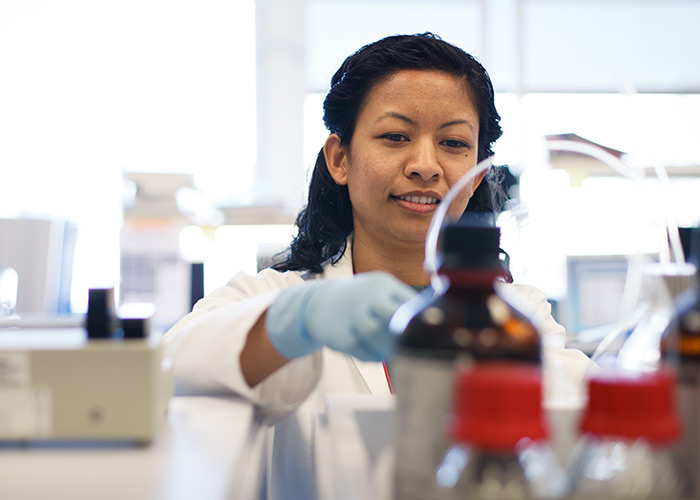Latent Tuberculosis Infections: A Major Public Health Challenge
Biochemistry’s Sujina Mali Studying Mechanisms of Bacterial Dormancy
According to the World Health Organization, one-quarter of the world’s population is infected with Mycobacterium tuberculosis, the bacteria that causes tuberculosis. For most, this infection is latent, with people showing no symptoms.
 Sujina Mali, a Ph.D. student in biochemistry, studies the mechanism of bacterial dormancy.“Many bacteria, including the one that causes TB, can enter a dormant stage, where
they are metabolically inactive,” said Sujina Mali, a Ph.D. student in biochemistry
at the University of Houston. “At this stage, antibiotics will not work against bacteria.”
Sujina Mali, a Ph.D. student in biochemistry, studies the mechanism of bacterial dormancy.“Many bacteria, including the one that causes TB, can enter a dormant stage, where
they are metabolically inactive,” said Sujina Mali, a Ph.D. student in biochemistry
at the University of Houston. “At this stage, antibiotics will not work against bacteria.”
Bacterial Dormancy: Underlying Cause of Latent TB Infections
Although people with latent TB infections are not contagious, they have a 5-15 percent lifetime chance of their infection being reactivated. The risk is even higher in patients with compromised immune systems.
Mali studies the mechanism of bacterial dormancy, which is the underlying cause of latent infections. Her research is conducted under the guidance of Steven Bark, an assistant professor of biology and biochemistry in the College of Natural Sciences and Mathematics.
“Sujina Mali is an exceptionally capable scientist, who can hold her own with the field’s best,” Bark said. “She has the rare ability to identify what she doesn’t understand, and who to ask.”
A Barrier for Reducing Active TB Infections
During dormancy, growth and development stop, with bacteria slowing down its metabolism in order to conserve energy. This way, bacteria can survive for months, sometimes years, under some of the harshest conditions.
This slowed-down metabolism also makes antibiotics ineffective, which means latent infections are incredibly difficult to eliminate.
Reactivation of TB, the symptoms of which can sometimes take weeks or months to develop, often leads to further spreading of the disease.
The mechanism by which bacteria can enter dormancy, and, later, get reactivated, is still largely unknown.
Micrococcus luteus: A Model System for Understanding Dormancy
“We study the Micrococcus luteus bacteria because it is known to enter this dormant state, but doesn’t cause disease in humans, which makes it easy to work with, compared to TB,” Mali said.
Micrococcus luteus also has the advantage of being closely related to the bacteria that causes TB. This means that whatever insights they gain will likely apply to TB as well.
“Micrococcus luteus secretes a protein that helps it come out of dormancy,” Mali said. “This same protein from Micrococcus luteus can also revive TB.”
During the course of her work, Mali has identified a number of different proteins that could play a role in bacterial dormancy. Her work has been recently published in Journal of Bacteriology. In collaboration with professor of biochemistry Dr. William Widger, the Bark lab is now working on understanding the mechanism by which these proteins cause dormancy.
“If we can target the dormant bacteria and prevent it from coming out of dormancy, then we can prevent reactivation of infections,” Mali said.
- Rachel Fairbank, College of Natural Sciences and Mathematics
March 14, 2018